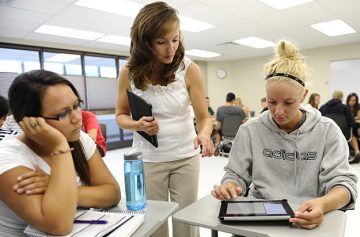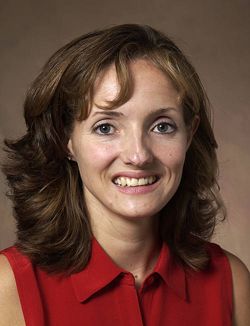Story
Driving Improvement with Data
DATE
December 22, 2019

By Andy Steiner

Stacy Duffield
Associate Professor Stacy Duffield and her colleagues at North Dakota State University have always wanted to create the best teacher-preparation program in the nation. But it wasn’t until they began collaborating with the 13 other partners in the Foundation’s Teacher Effectiveness Initiative (TEI) that they were able to collect the robust data that drive their improvement strategies today.
To get a more accurate measure of NDSU’s program performance, Duffield has collaborated with assessment personnel from the 13 other colleges and universities to design and implement a new system they all use to gather and compare feedback about their teacher-preparation programs. They call it the Common Metrics system.
Over the last five years, the Common Metrics system has designed and administered, with support from TEI and two technical assistance consultants, four surveys that span a teacher candidate’s path from entering teacher preparation through the first teaching year. The surveys cover factors from what inspired the candidate to teach, to how well they apply specific teaching skills. All participating programs use the resulting aggregate data to inform their improvement strategies.
“In the end, what we’re really focused on is creating the best teachers,” she says. “We want the kids in our region to have the best education in the nation. We can use data to reach that goal.” – Stacy Duffield, North Dakota State University
Although the teacher-preparation institutions that make up the Common Metrics system compete for teacher candidates, they have committed to working together for the common good of their teacher trainees — and the young people they will be educating. This is key to the project’s success, Duffield believes. “Our collaboration is really about program improvement and preparing better teachers. We just want to make ourselves better as a group. We’re a cohesive group with a lot of trust.”
Evaluators who conducted the midpoint evaluation of TEI recognized the collaborative as one of the biggest successes to emerge thus far from the Foundation’s current work.
“From the beginning of the Teacher Effectiveness Initiative, the need for a way to share data across the partners was clear,” says Allison Barmann, the Foundation’s vice president for strategy and learning. “It is to the partners’ credit that they’ve looked beyond what it would mean to share their data to how doing so can benefit each of them and the teachers they prepare.”
The partners in the Common Metrics system have presented papers on the results of their collaboration at education conferences, most recently in spring 2015 at the annual conference of the American Association of Colleges for Teacher Education. “We have really high-quality, well-aligned instruments that are the envy of many teacher preparation programs around the nation,” Duffield says. “When we present at national conferences, our room is just packed.”
While that professional acclaim is nice, Duffield says that the best measure of the Common Metric system’s success is the quality of teachers the participating institutions produce.
“In the end, what we’re really focused on is creating the best teachers,” she says. “We want the kids in our region to have the best education in the nation. We can use data to reach that goal.”

Great Teachers Great Minds
Even before there was a Bush Foundation, Archibald Bush invested in education, through supporting both individuals of promise and educational institutions.
Continue reading
-

News
Opportunity to work with us
As part of our office move later this year, we are exploring possibilities for the build out of the ground floor of the building. We are in the early stages of this and considering different types of operating models and potential partnerships.
-

Staff note
Coordinating the work of our contact hub
We aim to be radically open in all that we do, and that includes being more accessible to more people and sharing what we learn along the way.
-

Staff note
Making every dollar work through impact investing
We have benefitted from the experience of other funders as we developed our impact investing approach. Now we are paying it forward and sharing what we have done and what we have learned.